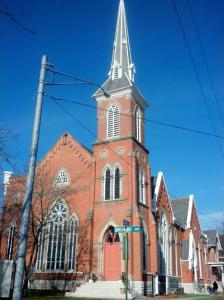Over the weekend while driving home from Chicago I stopped in Fremont, Ohio to attend the Methodist congregation of President Rutherford B. Hayes. I also visited his home and presidential library, the first such publicly available library of any president.
As a young man, the future Civil War general and chief executive attended Methodist Norwalk Seminary in Norwalk, Ohio. Although not always an active churchman, he was later strongly influenced by his Methodist wife, Lucy. She was a devout Methodist who attended Cincinnati Wesleyan Female College in Cincinnati. As First Lady and later she was cited as “Lemonade Lucy” because of her advocacy of temperance. She also was an abolitionist and reputedly influenced her husband towards anti-slavery causes and other social reforms. Perhaps to compensate for his presidency’s failures to protect the rights of southern blacks as Reconstruction ended, Hayes devoted much of his retirement to education for black children.
The Hayes’ attended First Methodist Episcopal Church in Fremont. He had been a successful lawyer before the Civil War. His military fame led him to politics, and he served in Congress and as Ohio governor. The Hayes’ regularly attended and generously supported their church, especially to facilitate its expansion, and then its reconstruction in 1888 after it burned down. In the 1960s the church, by now renamed after Hayes, had so grown in membership that it sold its old downtown sanctuary and built a new building on the edge of town.
Now called Hayes Memorial United Methodist Church, the congregation last Sunday had about 100 or so in attendance. The relatively young pastor, currently studying at United Methodist Garrett Evangelical Seminary, seems very focused on the early church fathers, and very high church. He processed into the sanctuary with an acolyte bearing a cross. During the Eucharist he donned additional vestments. The service was very liturgical and, by Methodist standards, almost Anglo-Catholic. Rich with substance, the worship was refreshingly longer than many modern Methodist services.
I detected no visible remembrance of President Hayes at his church. Later I learned that his pew was in fact there, having been relocated during the 1960s move. After the 10:30am service, I rushed downtown to see the original Methodist sanctuary where Hayes attended, unsure of its current owners. Now called Heritage Church, a nondenominational congregation, I found about 50 or 60 at worship, while a man prayed with deep conviction from the pulpit. Afterwards I learned he is the husband of the pastor. She is a black woman, while her husband and nearly all the congregation are white. She and her husband were very warm and told me a little about the Hayes history, saying the sanctuary was virtually as it appeared in his day, except for his missing pew. The stained glass windows were beautiful. The pastor’s husband showed me an overflow room next to the sanctuary, whose original wood floors he had refinished. As I departed, the pastor’s husband asked if he could help me with any money, perhaps gas money to get home! I smilingly responded that I would be glad to accept money but could not say I needed it! He smiled back. Dressed in a dark suit and tie, I don’t think I looked indigent. But this church obviously is generous and probably accustomed to helping strangers, whatever their appearance. Probably President and Mrs. Hayes would approve.
Hayes became president in 1877 despite having lost the popular vote. A special commission had to decide who won the electoral vote. Republican Reconstruction governments in several southern states claimed he had won their states. Their claims were questionable. But they were balanced by the fact that other southern states had clearly prevented Republican blacks from voting. The commission essentially granted Hayes the presidency with the tacit understanding that Hayes would remove remaining U.S. occupying troops from the south. He would do so, essentially ending Reconstruction and also hopes for ongoing full legal rights for former slaves and their descendants for another century.
President and First Lady Hayes regularly attended Foundry Methodist Episcopal Church in Washington, D.C. no matter the weather, often walking from the White House. Some said they wanted to give the coachman Sunday off. In later years, Foundry Church named a training school of young deaconesses after Lucy Hayes. In retirement back in Fremont, she later became president of the Methodist Missionary Society. In 1884, (according to an online article by EMILY APT GEER) she implored of the society that in addition to the “uninformed, destitute, and unfortunate of our own race. . . we must add the just claims of the lately emancipated people and their posterity, of the Indians, of the Mormons, of the Spanish Americans, and the Chinese now within our borders – all of whom, it has been well said, have claims upon us for Christian civilization not to be surpassed by those of the heathen of foreign lands.” In 1887 she told her fellow Methodist women that the “best hope for humanity is in America.” Mrs. Hayes also warned, “If, by reason of our neglect of our homework, the stream of unchristian tendencies from abroad, and the flood of indifference and vice in our own country, shall overwhelm our cherished institutions, all missionary work, at home and abroad, will suffer alike by the common calamity.” When President Hayes died in 1893, 4 years after his wife, his last words were: “I know that I’m going where Lucy is.”







Comment by Tammy on March 26, 2020 at 1:43 pm
I have purchased a stained glass window from the church president Hayes funded and attended. I’d like to find some photo of original window and historical value that I can display next to window